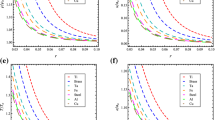Abstract
An analytical theory of the process of wave generation at the contact boundary in explosion welding is constructed using the mechanism of hydrodynamic instability. The significant action of the viscous and inertial forces that develop in an intense collision in the yield-state region of the samples is assumed to be the determining factor. The results are in agreement with experimental data and explain the observed effects. The particular case of a smaller welding gap is considered.
Similar content being viewed by others
References
A. A. Deribas,Physics of Hardening and Explosion Welding [in Russian], Nauka, Novosibirsk (1980).
V. M. Kudinov and A. Ya. Koroteev,Explosion Welding in Metallurgy [in Russian], Metallurgiya (1978).
Explosion Welding: Bibliographic Reference Book of Domestic and Foreign Literature in 1944–1978 [in Russian], Novosibirsk (1980).
V. M. Kudinov and A. Kh. Bunatyan, “Hydrodynamic modeling of the process of wave generation in explosion welding of metals,”Avtomat. Svarka, No. 8, 71–74 (1971).
Yu. A. Gordopolov, A. N. Drezin, and A. N. Mikhailov, “Theory of waves at the boundary of explosion-welded metals,”Fiz. Goreniya Vzryva,14, No. 4, 77–86 (1978).
V. A. Kuleshov, “Wavy lines of joint of metals upon explosion welding,”Avtom. Svarka No. 3, 22–25 (1985).
V. M. Kornev and I. V. Yakovlev, “Model of wave generation upon explosion welding,”Fiz. Goreniya Vzryva,20, No. 2, 87–90 (1984).
S. K. Godunov, A. A. Deribas, I. D. Zakharenko, and V. I. Mali, “A study of the viscosity of metals upon high-speed collisions,”Fiz. Goreniya Vzryva,7, No. 1, 135–141 (1971).
A. N. Kriventsov and V. S. Sedykh, “The role of plastic degeneration of metals in the zone of joint in explosion welding,”Fiz. Khim. Obrab. Mater., No. 1, 131–141 (1969).
S. K. Aslanov, “Theory of wave generation at the contact surface in explosion welding,” in:Physics of Pulse Effects on Condensed Media: Abstract of the VI Sci. Schools, Nikolaev [in Russian], (1993), pp. 141–142.
S. K. Aslanov, “Kinetics of subdivision of liquid particles in a gas flow and the theory of aerosol detonation,”Dokl. Akad. Nauk Ukraine, No. 5, 114–118 (1997).
A. N. Dremin and A. N. Mikhailov, “Observation of the process of wave generation in high-speed collision of plates by the method of light reflection,” in: Materials of the IV Int. Symp. on Explosion Treatment of Metals, Gotvaldov, Czechoslovakia (1979), pp. 29–39.
Yu. A. Alekseev and G. M. Smirnova, “Explosion welding of steel plates with small gaps between them,”Fiz. Khim. Obrab. Mater., No. 3, 123–128 (1993).
Yu. A. Alekseev, L. I. Lepekhina, and G. M. Smirnova, “Surface effects at an oblique impact of metal plates,”Fiz. Khim. Obrab. Mater., No. 3, 140–143 (1992).
S. K. Aslanov, “Kinetics of subdivision of liquid particles in a gas flow and the theory of aerosol detonation,” Preprint, Institute of Geophysics, Kiev, Ukraine (1996).
Author information
Authors and Affiliations
Additional information
Translated fromFizika Goreniya i Vzryva, Vol. 35, No. 4, pp. 112–117, July–August 1999.
Rights and permissions
About this article
Cite this article
Aslanov, S.K. Theory of wave generation in explosion welding. Combust Explos Shock Waves 35, 453–457 (1999). https://doi.org/10.1007/BF02674484
Received:
Issue Date:
DOI: https://doi.org/10.1007/BF02674484



